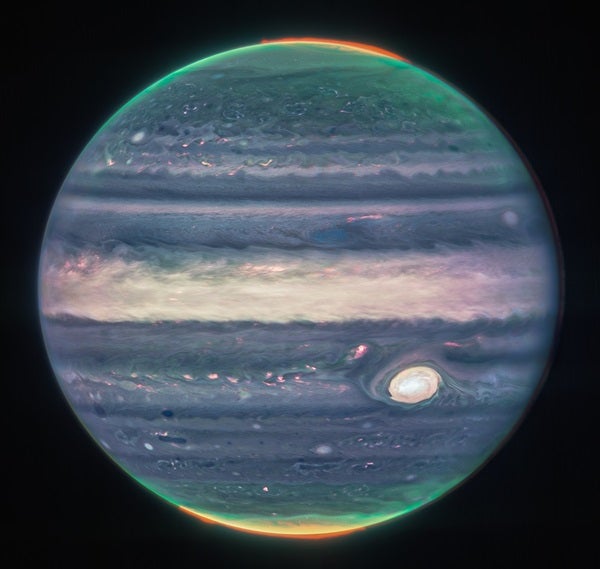
Jupiter's equatorial zone and Great Red Spot stand out in this infrared image from the James Webb Space Telescope because their high-altitude haze reflects sunlight well. Also notice the bright auroral emissions near the giant planet's north and south poles. Credit: NASA/ESA/Jupiter ERS Team; image processing by Judy Schmidt
Dark matter is a mysterious substance that makes up about 85 percent of the total matter in our universe. Although we can't see it, can We see their gravitational fingerprints in the way galaxies move and the way massive objects bend light around them. And now, researchers might have found a way to turn giant exoplanets into sensitive detectors of dark matter particles, researchers say — and a new study of our own planet Jupiter shows how the method would work.
The article was published on June 27 in Physical examination letters.
Since dark matter permeates space, researchers say the enormous gravity of gas giant planets should draw dark matter particles into an invisible cloud that surrounds and permeates them. There, collisions between dark matter particles in their upper atmospheres could produce light, as well as an increase in the amount of trihydrogen (H3+) there.
I3+ Dark matter can be created in a planet’s atmosphere in many ways, including through interactions with cosmic rays, solar wind and lightning. In this case, however, the researchers examined Cassini spacecraft observations of Jupiter’s dark side, made when the spacecraft came within 6.2 million miles (10 million kilometers) of the planet in 2000 and 2001, while en route to the Saturn system. They reasoned that observing the dark side — particularly at latitudes and times when the Jovian aurora was not likely to be active — could reveal signs of dark matter annihilation around the giant planet.
They didn’t detect any such glow in Jupiter’s upper atmosphere; however, as with many “null results” in science, this isn’t bad news. Instead, the researchers used the lack of detection to calculate a maximum size for dark matter particles.
Putting a size limit on dark matter
One of the leading theories about dark matter is that it is made up of so-called weakly interacting massive particles, or WIMPs. It is not known exactly what particles these might be. The WIMP model states that dark matter particles have some mass—unlike particles with zero mass, such as photons—and must be about the size of a proton.
These dark matter particles must be flowing through all the planets in the solar system all the time, but usually without interacting.
According to the University of Chicago particle astrophysicist Dan HooperAccording to a rough estimate by someone not involved in the study, up to 2.2 pounds (1 kilogram) of dark matter passes through Jupiter every second.
The planet's intense gravity means that some of those particles must have formed an invisible cloud in and around Jupiter that has built up over billions of years; and collisions between those invisible particles could create radiation. And in theory, that radiation would create an excess of H3+ which could be detected as an infrared glow in Jupiter's upper atmosphere, Hooper says.
That glow is what the authors of the latest study hoped to detect.
But “when Cassini pointed its instruments toward the night side of Jupiter, it saw absolutely nothing,” says dark matter physicist Carlos Blanco of Princeton University, lead author of the study.
Such a lack of detection—known in science as a “null result”—is akin to Sherlock Holmes solving a mystery because a dog didn’t bark.
Blanco and her co-author, astroparticle physicist Rebecca Leane of Stanford University, calculate that dark matter particles must have a cross section smaller than 10-38 centimeter2In physics, the cross section of a particle is related to the probability that the particle will interact with other particles. And if dark matter particles were larger, they would interact more frequently, creating a detectable signal.
That cross section is smaller than what dark matter detection experiments here on Earth can detect, and the researchers say it shows the value of their approach.
“The kind of detectors that you can put in a lab on Earth are really only sensitive to dark matter particles that are heavier than hydrogen, and they start to lose sensitivity very quickly if the dark matter is lighter,” Blanco says. “What we found is that, in general, looking at the signals that dark matter might leave behind in molecules like H3+ “It’s a good way to overcome that threshold and move to increasingly lighter particles.”
One step closer
The null result on Jupiter is just the beginning.
The authors suggest that the infrared glow created by collisions between dark matter particles might be easier to detect in the atmospheres of exoplanets with more mass than Jupiter, particularly in regions with more dark matter, near the center of our galaxy, for example.
“What we are really looking for is something big, like a ‘super-Jupiter’ (a planet more massive than Jupiter), that is closer to the galactic center, where there is a higher concentration of dark matter,” he says. “That way you would expect a higher signal.”
However, it is not currently possible to detect such glows on exoplanets, but Blanco hopes that such technology will soon be developed, although he cautions that astronomers would have to improve the sensitivity of the relevant instruments by two or three times for them to be effective.
“That's very far away,” says cosmologist Joseph Silk of Johns Hopkins University, who was not involved in the study.
Still, it's one more possible way that astronomers might one day see into the invisible and uncover the true nature of the mysterious dark matter that permeates our universe.